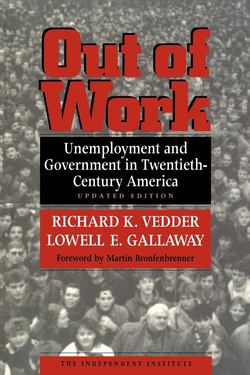Читать книгу Out of Work - Richard K Vedder - Страница 12
На сайте Литреса книга снята с продажи.
Variations in Unemployment over Time
ОглавлениеThe problem of unemployment was not merely that it was growing dramatically in size over time, but that its magnitude varied significantly over time and space, often striking individuals unexpectedly before they could prepare for it. Over the first nine decades of the twentieth century, the official annual unemployment rate averaged 6.6 percent, but varied between 1.2 percent and 24.9 percent.5 Even if one looks at decade averages of unemployment (see table 1.1), the variation in rates is still huge. The 1930s stands out as an extraordinary aberration—mean unemployment rates well over double the next highest unemployment decade (the 1980s). Yet even the 1980s witnessed a mean decade unemployment rate over 50 percent higher than in four other decades (the 1900s, 1920s, 1950s, and 1960s.)
TABLE 1.1 VARIATIONS IN UNEMPLOYMENT IN THE U.S., BY DECADES, 1900–1990
The bad news from table 1.1 is that the lowest mean unemployment rates tended to come early or in the middle of the century: the mean unemployment rate rose steadily by decade after the 1950s, and even the 1950s figure was higher than observed in the very first decade of the century. Whereas unemployment rates of 5 percent or less tended to be the rule rather than the exception in the period 1900–29 and also in the era from 1940 to 1969, by the 1980s unemployment rates that low simply did not occur.
The good news from table 1.1 is that the absolute variation around the mean or median unemployment rate was lower in the last half of the century than in the first half, reaching a nadir in the 1960s, when the highest unemployment rate for the decade was a mere 3.2 points above the lowest rate, and the standard deviation barely exceeded one. The good news with respect to unemployment variation is tempered, however, by the fact that moderate increases in fluctuations were observed after the 1960s.
Moreover, the official data for the first decades of the century were constructed from decennial census “benchmark” data, and are thus subject to considerable error. Christina Romer has made a compelling case that the variation in unemployment in the early decades of the twentieth century was much less than the official numbers indicate, and that the postwar unemployment instability is understated, suggesting that the observed reduction in unemployment instability shown in table 1.1 is in fact in large part a statistical artifact.6
It is tempting to try to draw broad-brush conclusions about trends in unemployment by comparing data for various subperiods in the twentieth century. The conclusion one reaches, however, is highly sensitive to the periods chosen. If one arbitrarily divides the ninety years of available data in half, the evidence shows that the mean unemployment rate in the first half, 1900–44 (7.9 percent), is considerably higher than in the last half, 1945–89 (5.49 percent). Moreover, unemployment variation (as measured by the standard deviation), is dramatically lower in the latter period. On the basis of this evidence, the inclination is to accept the conventional wisdom that the unemployment record has been clearly superior in the period of governmental activism that followed the Employment Act of 1946.
Yet one could just as rationally divide the twentieth century into three equal periods of thirty years each: 1900–29, 1930–59, and 1960–89. The first period is an era of very limited direct governmental involvement impacting on unemployment, the middle period is a transitional era where an interventionist policy came to be increasingly accepted, and the latter period is one of consistent governmental activism in the economy, albeit with increased skepticism about its effectiveness as the period unfolded.
The mean unemployment rate of 4.7 percent in the first (nonintervention) period was far lower than the 6.09 percent rate observed from 1960 to 1989, or the 9.3 percent average rate in the transitional era of 1930–59. While unemployment variation was somewhat lower in the 1960–89 period than in the early decades (standard deviation of 1.60 versus 2.29), Romer’s insight suggests that this almost entirely reflects faulty data rather than a real phenomenon. Using this tripartite division, the evidence generally points to the conclusion that the unemployment situation was better in the relatively laissez-faire era before the Great Depression than in periods since.
